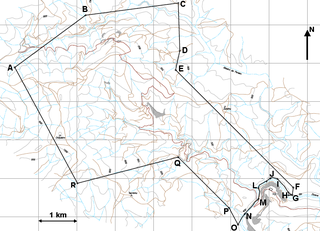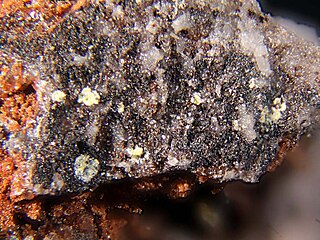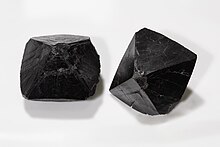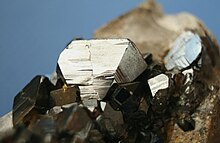
Wolframite is an iron, manganese, and tungstate mineral with a chemical formula of (Fe,Mn)WO4 that is the intermediate mineral between ferberite (Fe2+ rich) and hübnerite (Mn2+ rich). Along with scheelite, the wolframite series are the most important tungsten ore minerals. Wolframite is found in quartz veins and pegmatites associated with granitic intrusives. Associated minerals include cassiterite, scheelite, bismuth, quartz, pyrite, galena, sphalerite, and arsenopyrite.

Galena, also called lead glance, is the natural mineral form of lead(II) sulfide (PbS). It is the most important ore of lead and an important source of silver.

Cuprite is an oxide mineral composed of copper(I) oxide Cu2O, and is a minor ore of copper.

Scheelite is a calcium tungstate mineral with the chemical formula CaWO4. It is an important ore of tungsten (wolfram). Scheelite is originally named after Swedish chemist K. Scheele (1742-1786). Well-formed crystals are sought by collectors and are occasionally fashioned into gemstones when suitably free of flaws. Scheelite has been synthesized using the Czochralski process; the material produced may be used to imitate diamond, as a scintillator, or as a solid-state lasing medium. It was also used in radium paint in the same fashion as was zinc sulphide, and Thomas Edison invented a fluoroscope with a calcium tungstate-coated screen, making the images six times brighter than those with barium platinocyanide; the latter chemical allowed Röntgen to discover X-rays in early November 1895.

Vivianite (Fe2+
Fe2+
2(PO
4)
2·8H
2O) is a hydrated iron phosphate mineral found in a number of geological environments. Small amounts of manganese Mn2+, magnesium Mg2+, and calcium Ca2+ may substitute for iron Fe2+ in the structure. Pure vivianite is colorless, but the mineral oxidizes very easily, changing the color, and it is usually found as deep blue to deep bluish green prismatic to flattened crystals.
Vivianite crystals are often found inside fossil shells, such as those of bivalves and gastropods, or attached to fossil bone.

The tin mining industry on Dartmoor, Devon, England, is thought to have originated in pre-Roman times, and continued right through to the 20th century, when the last commercially worked mine closed in November 1930. From the 12th century onwards tin mining was regulated by a stannary parliament which had its own laws.

Hübnerite or hubnerite is a mineral consisting of manganese tungsten oxide (chemical formula MnWO4). It is the manganese endmember of the manganese–iron wolframite solid solution series. It forms reddish brown to black monoclinic prismatic submetallic crystals. The crystals are typically flattened and occur with fine striations. It has a high specific gravity of 7.15 and a Mohs hardness of 4.5. It is transparent to translucent with perfect cleavage. Refractive index values are nα = 2.170 - 2.200, nβ = 2.220, and nγ = 2.300 - 2.320.

Bismuthinite is a mineral consisting of bismuth sulfide (Bi2S3). It is an important ore for bismuth. The crystals are steel-grey to off-white with a metallic luster. It is soft enough to be scratched with a fingernail and rather dense.

Stannite is a mineral, a sulfide of copper, iron, and tin, in the category of thiostannates.

Sperrylite is a platinum arsenide mineral with the chemical formula PtAs2 and is an opaque metallic tin white mineral which crystallizes in the isometric system with the pyrite group structure. It forms cubic, octahedral or pyritohedral crystals in addition to massive and reniform habits. It has a Mohs hardness of 6 - 7 and a very high specific gravity of 10.6.

Minas da Panasqueira or Mina da Panasqueira is the generic name for a set of mining operations between Cabeço do Pião and the village of Panasqueira, which operated in a technically integrated manner and continue practically since its discovery. Subsequently, it was agglomerated into a single administrative entity called Couto Mineiro da Panasqueira which had its last demarcation on 9 March 1971 and later in the present Exploration Concession C18 (16/12/1992). The mining installations are currently centralised in the area of Barroca Grande-Aldeia de S. Francisco de Assis (Covilhã) i.e. access to underground exploration, extraction and processing of ore.

Franckeite, chemical formula Pb5Sn3Sb2S14, belongs to a family of complex sulfide minerals. Franckeite is a sulfosalt. It is closely related to cylindrite.
Joseph Carne was a British geologist and industrialist.

Russellite is a bismuth tungstate mineral with the chemical formula Bi2WO6. It crystallizes in the orthorhombic crystal system. Russellite is yellow or yellow-green in color, with a Mohs hardness of 3+1⁄2.

Hushing is an ancient and historic mining method using a flood or torrent of water to reveal mineral veins. The method was applied in several ways, both in prospecting for ores, and for their exploitation. Mineral veins are often hidden below soil and sub-soil, which must be stripped away to discover the ore veins. A flood of water is very effective in moving soil as well as working the ore deposits when combined with other methods such as fire-setting.

Drakelands Mine, also known as Hemerdon Mine or Hemerdon Ball Mine, is a tungsten and tin mine. It is located 11 km northeast of Plymouth, near Plympton, in Devon, England. It lies to the north of the villages of Sparkwell and Hemerdon, and adjacent to the large china clay pits near Lee Moor. The mine had been out of operation since 1944, except for the brief operation of a trial mine in the 1980s. Work started to re-open it in 2014, but it ceased activities in 2018. It hosts the fourth largest tin-tungsten deposit in the world.

Tin is an essential metal in the creation of tin-bronzes, and its acquisition was an important part of ancient cultures from the Bronze Age onward. Its use began in the Middle East and the Balkans around 3000 BC. Tin is a relatively rare element in the Earth's crust, with about two parts per million (ppm), compared to iron with 50,000 ppm, copper with 70 ppm, lead with 16 ppm, arsenic with 5 ppm, silver with 0.1 ppm, and gold with 0.005 ppm. Ancient sources of tin were therefore rare, and the metal usually had to be traded over very long distances to meet demand in areas which lacked tin deposits.

Malayaite is a calcium tin silicate mineral with formula CaSnOSiO4. It is a member of the titanite group.
Tin mining began early in the Bronze Age, as bronze is a copper-tin alloy. Tin is a relatively rare element in the Earth's crust, with approximately 2 ppm, compared to iron with 50,000 ppm.

Porco caldera is a caldera in Bolivia which contains a major deposit of lead, silver, tin, and zinc ore. This caldera was formed by a volcanic eruption 12 million years ago in the Bolivian Cordillera Oriental. Subsequent to the caldera collapse, volcanic intrusions occurred as many as 3 million years after the caldera formation.






















